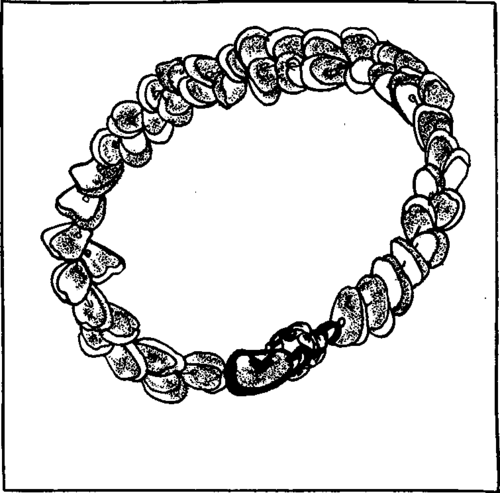Vegetable Dyes
Description
This section is from the book "Use Of Native Craft Materials", by Margaret Eberhardt Shanklin. Also available from Amazon: Use Of Native Craft Materials.
Vegetable Dyes
The merits of aniline and vegetable dyeing have been tried. For fastness and greater variety of color the commercial dyes are more reliable. However, the beauty of a vegetable-dyed piece of cloth still holds a charm for the weaver and the embroiderer. The early pioneers of Kansas used onion skins, walnut hulls, bark, and other natural materials for dyestuffs. Easter eggs were wrapped in onion skins and placed in a hot salt or vinegar bath to make them red or yellow. Little boys suits were dyed a rich dark brown with walnut hulls. The stain of berries was used for dull blues and purples.

Figure 21. A braided cord for a necklace.
An interesting account of how walnut dye was made by a Southern Highland woman is quoted from Eaton's "Handicrafts of the Southern Highlands," page 143:

Figure 22. A bracelet with a button fastener.
Walnut Dye.—You want to get your roots and sprouts. Git 'em on the new moon in June. Skin 'em from the root up. Bile 'em about two or three hours. Bile just about one ooze. Put your wool in the ooze and bile it. If it haint dark enough, take out and bile more bark and put it in that. A grain of copperas'll make it darker. If you hang it out in the sun, hit'll turn dark.
She is also quoted as follows:
Git brown sage (sedge or slough grass), and bile it and put in a little alum. It makes the prettiest yaller that ever was.
Many plants, fruits, vegetables, and trees furnish dye material. A general rule to follow in experimenting with vegetable dyes is to soak the plants in water overnight. Then they should be boiled an hour or more to give the desired intensity. The dye should be strained to remove the plant matter, or the chopped dyestuff may be placed in a loosely woven cotton sack and lifted out when all of the coloring has been released from the plants, as when using tea balls.
A copper or enamel kettle should be used for dyeing. Smooth wooden sticks are used for stirring and lifting. Sufficient water to cover the cloth to be dyed should be placed in the kettle and brought to a boil. The concentrated dye is then added to the water. The cloth, which has been previously washed to remove starch and sizing, should be well covered by the dye bath.
To make the dye fast, it is usually necessary to treat the material before dyeing it. If the cloth is wool, cream of tartar is added to an alum bath, 1/4 ounce to each gallon of water. If the material is cotton, linen, or rayon, 1/4 ounce of ordinary washing soda is added. The alum bath is made by adding 1 ounce of powdered alum to a gallon of water. The cloth should be boiled slowly for an hour and then rinsed well before immersing it in the dye bath.
The plants which are to be used for dyeing must be gathered when they are young. The roots are collected in the autumn and the leaves just as they are becoming full grown. Berries and seeds should be gathered when they are ripe. Flowers yield their dye easily but should not be boiled too long.
The thick taproot of the dandelion is used by the Scotch for dyeing their Highland tartans. It gives a dull magenta color.
The common elderberry shrub gives two colors. The leaves when used with an alum mordant give a green color, and the purple berries, when used with an alum and salt mordant, make a blue-violet dye. The dye is violet when the alum mordant alone is used.
The golden rod yields a yellow dye. The plant and flower heads should be chopped into small pieces, put in water, and brought slowly up to a boil. The liquor should be allowed to simmer for several hours and then allowed to cool. The next day it should be heated again and the mordanted cloth added and allowed to simmer until the desired color is obtained.
The outer yellow and red skins of onions should be boiled for two hours and the previously mordanted cloth added and boiled for another hour. This is not a very good dye.
Pear leaves well bruised and brought to a boil release a dull yellow color.
The shells and husks of walnuts are both used for a brown dye. The dye formed by soaking the ripe walnut husks in water needs no mordant. If an alum mordant is used, the dye is made a yellow-brown. The husks may be boiled a half hour and allowed to cool. Then the material is added and it is boiled again until the desired shade is obtained.
The powdered leaves of sumac give a yellow-brown color, while the roots make a yellow dye. The berries make a purple shade.
Sunflower seeds and larkspur flowers are said to make a blue dye.
Beets make a red-violet dye.
Dyeing is an ancient art. It is another use of the materials at hand to make lovelier things for people to use.
Continue to:


